R.J. Stowell's Blog: rjsomeone, page 45
July 3, 2019
Morrison - On This Day - 48 Years Ago
 On March 11, 1971, Morrison met up with Pam Courson in Paris for a Doors sabbatical; the goal, to get clean, to lose weight, to reconnect with his muse. Three months later, on the morning of his death, July 3, 1971, in their apartment at No. 17 Rue Beautreillis, Jim stayed up listening to old Doors albums, trying to suppress a coughing fit. When he came to bed, he woke Pamela, complaining that he felt sick, and when he threw up a small amount blood, Courson suggested they call a doctor. Jim, instead, asked Pam to run him a bath. The last thing she remembed hearing was Jim asking, "Are you there, Pam? Pam, are you there?" Courson awoke a little after 6am with Jim's side of the bed empty. She found him submerged in the water; a smile on his face.
On March 11, 1971, Morrison met up with Pam Courson in Paris for a Doors sabbatical; the goal, to get clean, to lose weight, to reconnect with his muse. Three months later, on the morning of his death, July 3, 1971, in their apartment at No. 17 Rue Beautreillis, Jim stayed up listening to old Doors albums, trying to suppress a coughing fit. When he came to bed, he woke Pamela, complaining that he felt sick, and when he threw up a small amount blood, Courson suggested they call a doctor. Jim, instead, asked Pam to run him a bath. The last thing she remembed hearing was Jim asking, "Are you there, Pam? Pam, are you there?" Courson awoke a little after 6am with Jim's side of the bed empty. She found him submerged in the water; a smile on his face.
Published on July 03, 2019 05:17
Brian Jones - On This Day - 50 Years Ago
 In his chronicle of the times, "Fallen Knights and Fallen Ladies" (from the book Nobody Waved Goodbye), Lou Reed said,
In his chronicle of the times, "Fallen Knights and Fallen Ladies" (from the book Nobody Waved Goodbye), Lou Reed said, After the Beatles came the Stones and of the Stones one could never have ignored Brian Jones with his puffed up Pisces, all-knowing, all suffering fish eyes, his incredible clothes, those magnificent scarves, Brian always ahead of style, perfect Brian. How could Brian have asthma, a psychological disease (we're told) and certainly something strange for a member of a rock and roll group. We read in interviews that Brian saw himself as the original lead Stone, a position he held until their American tour singled out Mick for the honor in the hearts of the American female. Can you remember 1964 when the Stones were called homosexual for long hair? (Were you?) Brian with two fourteen year old girls draped on each arm, must have laughed. And yet, the center of attention was drifting. In a group the attention may be evenly distributed (we all knew and loved John, Paul, George and Ringo) but in the Stones it was to be Mick. Now normally in a group an instrumentalist can never overshadow a lead singer (Exception: The Yardbirds where Eric Clapton, Jeff Beck and Jimmy Page did just that to poor Keith Relf). In the Stones there was Mick, the pivotal center. Charlie and Bill were for gourmets. That left Keith and Brian. Lead guitar always beats rhythm guitar for popularity, so that left Brian, who one assumes therefore turned to more and more exotic instruments to establish his presence to both himself and others. This is what I'm worth. Let me see you play the damn thing....but the great mass looked to Mick not Brian to be their leader through this Fall From Grace. And how can you take that? "But I started the thing," you might say. "It was my records in the first place, I turned them on, must I be a damn singer to turn on the world?" Yes, Or the champion of the guitar.
Then, of course, there are more problems, the drug arrests, the constant mental turmoil. What if they tour without me? Financial. Could I starve? (He died well in debt). If they play without me I shall be disgraced and have nothing where as if I leave and strike out on my own I'm out before they get me (how sad! how inevitable!), and I create my own myth, style, voice, the eyes will be on me, I have a future, there's so much I know, music, music, music, who would know it from THAT, I can do it, I have to do it, I will do it. And of course the disorientation, am I backwards, forwards, the asthma attack (I am going to choke), the fall (where is the pool?!) and everything settles like a quiet bubble coming in spurts and then thin streams until finally the last one has popped itself right out of earthly existence.

It was in June 1969 that Jones quit the band he'd founded and named The Rolling Stones. Jones played a pivotal role in the Stones' success, with his blond hair, Bohemian dress and good looks, as well as his ability to play any instrument within minutes of picking it up. Jones, though un-credited, co-wrote and played the recorders and cello on "Ruby Tuesday," sitar and tamboura on "Paint It, Black," dulcimer on "I Am Waiting" and "Lady Jane," the lead guitar riff on "Get Off My Cloud," harpsichord on "Yesterday's Papers," the trumpet and trombone on "Something Happened To Me Yesterday," the marimba on "Under My Thumb," and the autoharp on "You Got The Silver." All, today, unnoticed.

He began losing control of the group when Jagger and Richards began their songwriting partnership in 1965, which slowly moved the band away from Jones' blues-based direction. By 1966, Jones' mental instability and drug abuse had become a liability to the Stones. Due to his substance abuse problems, Jones frequently missed tour dates and recording sessions, and was unable to function within the band when he did attend.
While there is controversy over whether Jones quit the band or was "fired" (based supposedly on Jones' inability to obtain U.S. working papers for the upcoming North American tour). While Jones claimed that he quit the band, a settlement was reached that he'd receive $200,000 as severance and $40,000 per year for as long as the Stones remained a band. (With Mick Jagger's net worth at $305 mil., it doesn't seem like much in the way of severance.)
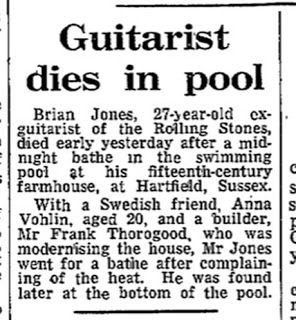 A month later, July 3, 1969, Jones was dead, found at the bottom of the swimming pool at his Cotchford Farm home. "Death by Misadventure" was the analysis of the coroner's office. A memorial service was held on the 10th at Cheltenham parish church, attended by Rolling Stones Charlie Watts and Bill Wyman (Mick Jagger was in Australia, where girlfriend Marianne Faithfull had been hospitalized following a suicide attempt). But the most lasting memorial was held two days after Jones' death, when his former bandmates paid tribute at the free concert in Hyde Park. Jagger, asking the audience to "cool it for a minute," read a poem by Percy Shelley before thousands of butterflies were released above the crowds. A fitting homage to a rock icon, and YET – were I a conspirist, I'd go into the whole murder thing, but I'm not; I'll leave that to the pale guy on ABC ("Could it be…murder?").
A month later, July 3, 1969, Jones was dead, found at the bottom of the swimming pool at his Cotchford Farm home. "Death by Misadventure" was the analysis of the coroner's office. A memorial service was held on the 10th at Cheltenham parish church, attended by Rolling Stones Charlie Watts and Bill Wyman (Mick Jagger was in Australia, where girlfriend Marianne Faithfull had been hospitalized following a suicide attempt). But the most lasting memorial was held two days after Jones' death, when his former bandmates paid tribute at the free concert in Hyde Park. Jagger, asking the audience to "cool it for a minute," read a poem by Percy Shelley before thousands of butterflies were released above the crowds. A fitting homage to a rock icon, and YET – were I a conspirist, I'd go into the whole murder thing, but I'm not; I'll leave that to the pale guy on ABC ("Could it be…murder?"). 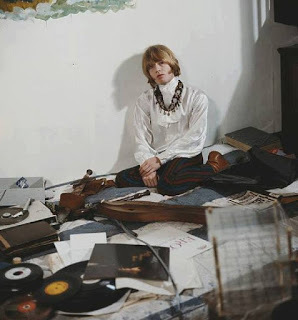 Better to leave off with the homage of Marianne Faithfull: "One of the best things about visiting Anita [Jone's gf] and Brian was watching them get ready to go out. What a scene! They were both dauntless shoppers and excessively vain. Hours and hours were spent putting on clothes and taking them off again. Heaps of scarves, hats, shirts and boots flew out of drawers and trunks. Unending trying on of outfits, primping and sashaying. They were beautiful, they were the spitting image of each other and not an ounce of modesty existed between two of them. I would sit mesmerized for hours, watching them preening in the mirror, trying on each other's clothes. All roles and gender would evaporate in these narcissistic performances, where Anita would turn Brian into the Sun King, Francoise Hardy or the mirror image of herself."
Better to leave off with the homage of Marianne Faithfull: "One of the best things about visiting Anita [Jone's gf] and Brian was watching them get ready to go out. What a scene! They were both dauntless shoppers and excessively vain. Hours and hours were spent putting on clothes and taking them off again. Heaps of scarves, hats, shirts and boots flew out of drawers and trunks. Unending trying on of outfits, primping and sashaying. They were beautiful, they were the spitting image of each other and not an ounce of modesty existed between two of them. I would sit mesmerized for hours, watching them preening in the mirror, trying on each other's clothes. All roles and gender would evaporate in these narcissistic performances, where Anita would turn Brian into the Sun King, Francoise Hardy or the mirror image of herself." On a personal note, I made a pilgrimage to Brian's grave in the mid '80s. Even then, the locals were still talking about him, and were eager to tell me stories in the pub about his funeral. At his grave was a crazy chick who was crying, all the way from Denmark.
Published on July 03, 2019 04:52
July 2, 2019
Buy The Book

Read the Book! AM, here on the web and on the radio, is sponsored by your patronage through the sale of R.J. Stowell's novel, Miles From Nowhere (and from Jay and the Americans). We've arranged for you to read Miles on Kindle Unlimited FREE, while the Kindle edition for those of you without KU is just $2.99. The trade edition is $10.99, a beautiful softbound edition perfect for relaxing in the sun.
And here's a new offer because you've asked. Now you can get a personally signed edition of either novel for just $15.99. I will sign the novel to you or a loved one with a personal note. Send an email to this link:
rjsomeone@gmail.com
Some of you emailed me about the cover art for Miles. I created the cover with a pen and ink drawing of the landscape. From there, I cartoonized a photo of a VW van and superimposed the peace symbol for the Kindle edition. For the trade paperback, I utilized the cartoon version of the van and created an ink drawing adding watercolor. I scanned the artwork and on the computer added the sun and its rays in the distance. I felt it was important to be hands-on with the cover as well as what was inside. It's the same approach I took with my first published novel, Jay and the Americans, also available from Amazon.

Published on July 02, 2019 19:12
July 1, 2019
The Last Time I Saw Richard - Joni Mitchell
 Joni Mitchell began her career busking and playing little clubs in Saskatoon Saskatchewan and in Toronto in the early 1960s with her husband, Chuck Mitchell. By the summer of 1969, she was a fixture in Laurel Canyon. Her first LP, Song to a Seagull, often called Joni Mitchellbecause the record company cut off part of the album cover's design, was produced by David Crosby. Crosby's production was meant to augment her singing style with one tactical error on his part. The idea was to have Joni sing into the opening of a baby grand piano to accentuate the reverb in her voice. That technique backfired and required David to edit out the excess vibration audible in the master tape. By doing so, the recording comes off a little flat, but maybe, as well, highlights the naivete in Joni's lilting soprano and youthful lyrics. The album isn't masterful but truly suggests what was yet to come. The LP is so overshadowed by Ladies of the Canyon, Blue, and Court and Sparkthat one is likely to overlook the LP, Clouds as well, Joni's sophomore effort, but that's unfair. The songs are talented and innovative, folky and naïve in a way that suggests the performance is more a private session; Joni truly solo.
Joni Mitchell began her career busking and playing little clubs in Saskatoon Saskatchewan and in Toronto in the early 1960s with her husband, Chuck Mitchell. By the summer of 1969, she was a fixture in Laurel Canyon. Her first LP, Song to a Seagull, often called Joni Mitchellbecause the record company cut off part of the album cover's design, was produced by David Crosby. Crosby's production was meant to augment her singing style with one tactical error on his part. The idea was to have Joni sing into the opening of a baby grand piano to accentuate the reverb in her voice. That technique backfired and required David to edit out the excess vibration audible in the master tape. By doing so, the recording comes off a little flat, but maybe, as well, highlights the naivete in Joni's lilting soprano and youthful lyrics. The album isn't masterful but truly suggests what was yet to come. The LP is so overshadowed by Ladies of the Canyon, Blue, and Court and Sparkthat one is likely to overlook the LP, Clouds as well, Joni's sophomore effort, but that's unfair. The songs are talented and innovative, folky and naïve in a way that suggests the performance is more a private session; Joni truly solo.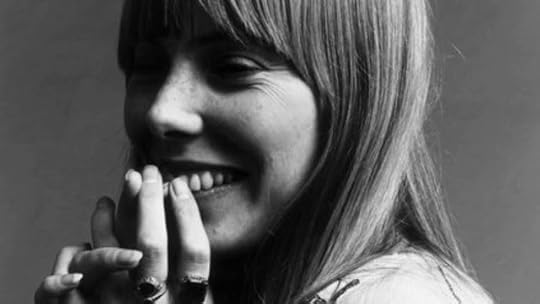
We'll devote more time to Joni in future posts, but since we spent last week on the story song, it seemed appropriate to approach the topic from the Joni perspective. Here we don't find the kitsch associated with story songs, even favorites like "Ode to Billie Joe" or Harry Chapin's "Taxi." This is hardcore realism. Joni's motif usually encompassing snippets of relationships as we, as the listeners, take what we will and fill in the missing pieces. Yet in Blue's "The Last Time I Saw Richard," we get a full-blown short story, start to finish. Whether about Chuck Mitchell (or Taylor or Crosby or Nash or…), that we don't know, but the scene opens with Joni recalling a barroom conversation three years prior in which an older ex-lover attempts to shut down her youthful enthusiasm with melancholy and disparate philosophical musings: "All romantics meet the same fate someday: cynical and drunk and boring someone in some dark café." Richard projects his misery onto her, scoffing when she laughs it off with his retort: "Roses and kisses and pretty men to tell you all those pretty lies." Richard is bitter, though a youthful Joni cuts him off as he wallows in his pain with gushy love songs in the background that he's put on the jukebox. The scene takes place, by the way, in 1968, around the time Joni was establishing herself in the Laurel Canyon/Hollywood scene. The song is classic storytelling that evokes the idea that as time progresses we grow apart, we’re not the people we once were. Joni's eyes are "full of moon" and poor Richard Whiney Pants in his self-pity merely comes off as comical; the guy you just want to say, "deal," or prescribe Zoloft.
"The Last Time I Saw Richard" is a story song masterstroke that could have been written by an Emily (Dickenson or Bronte). I'm hard pressed to include it with the others we've talked about on the radio program as it provides none of that kitsch or camp one would find in both the worst of the lot (Bobby Goldsboro's "Honey," Rupert Holme's "Escape") or the best (Bruce Springsteen's "Highway Patrolman," or Leonard Cohen's "Famous Blue Raincoat").
Published on July 01, 2019 05:06
June 28, 2019
Harry Chapin's Taxi
 Harry Chapin's short career as a singer/songwriter came to an end when he died in a car accident in 1981. He's remembered, of course, for his No. 1 single "Cat's in the Cradle" in 1974, a story song in itself, but his first single from his debut LP was "Taxi," which peaked at No. 24 on the Billboard charts.
Harry Chapin's short career as a singer/songwriter came to an end when he died in a car accident in 1981. He's remembered, of course, for his No. 1 single "Cat's in the Cradle" in 1974, a story song in itself, but his first single from his debut LP was "Taxi," which peaked at No. 24 on the Billboard charts."Taxi" tells the story of a cabbie who quite by chance picks up a woman who gives him an address in the rich part of town. As they drive along, mixing a little bit of small talk with awkward silence, each recognizes the other a lover from many years ago. They chat for a bit and Harry drops her at her destination.
He laments, "She was gonna be an actress, and I was gonna learn to fly." The brilliance of Chapin's storytelling is revealed when he returns to the image near the end of the song and turns it on its head:
And me, I'm flying in my taxi,Taking tips, and getting stoned.
On the radio show, AM on the Radio, on iHeart Radio and Daybreak USA I implied that the song was autobiographical, and indeed it was, involving a woman named Clare McIntyre-Ross, whom Harry dated for two years and the two went their separate ways. How much of the rest of it is true doesn't really matter, the emotions imparted in Harry's scarred vocal tell it all.
Published on June 28, 2019 12:59
June 24, 2019
Ode to Billie Joe - Bobby Gentry
 I've mentioned many times AM's obsession with finding some kind of connection between one post and the next, whether that connection is 1969 or literature or people Joni Mitchell slept with. I mentioned getting a 1961 Magnavox Collaro turntable, and so now every extra dollar goes towards vinyl. I suddenly have my own little connections that may not be as readily apparent as the ones you're used to. The other day, for instance, for $2.99 each, I got The Mason William Phonograph Record, a favorite when I was a kid ("Classical Gas"), Cat Stevens' Buddha and the Chocolate Box and Bobbie Gentry's Ode to Billie Joe, if only for the sentimental value. Turns out, the title track is classic Southern-American Gothic poetry that achieves its poetic value through subordination of event to situation. "Ode to Billie Joe" seems a simple narration of events, journalism-style: the narrator and Billie Joe throwing something off the bridge, Billie Joe jumping off the bridge, a pretty vivid picture. Yet the listener doesn't know what the pair are throwing off the bridge and we don't know why Billie Joe killed hisseff. What is revealed with utter clarity is the narrator's situation: she is spoken to and spoken about within the poem, but she herself is never allowed to speak; she is closely monitored (told to wipe her feet, interrogated for not eating, observed and reported on) but not recognized at all; she is kept in place by society, but is afforded no place in that society; on and on. In Aristotelian/English teacher terms, Bobbie Gentry's hit inverts the tragic focus on mythos for a lyric focus on ethos. It takes to heart Emily Dickinson's advice to "tell all the truth but tell it slant."
I've mentioned many times AM's obsession with finding some kind of connection between one post and the next, whether that connection is 1969 or literature or people Joni Mitchell slept with. I mentioned getting a 1961 Magnavox Collaro turntable, and so now every extra dollar goes towards vinyl. I suddenly have my own little connections that may not be as readily apparent as the ones you're used to. The other day, for instance, for $2.99 each, I got The Mason William Phonograph Record, a favorite when I was a kid ("Classical Gas"), Cat Stevens' Buddha and the Chocolate Box and Bobbie Gentry's Ode to Billie Joe, if only for the sentimental value. Turns out, the title track is classic Southern-American Gothic poetry that achieves its poetic value through subordination of event to situation. "Ode to Billie Joe" seems a simple narration of events, journalism-style: the narrator and Billie Joe throwing something off the bridge, Billie Joe jumping off the bridge, a pretty vivid picture. Yet the listener doesn't know what the pair are throwing off the bridge and we don't know why Billie Joe killed hisseff. What is revealed with utter clarity is the narrator's situation: she is spoken to and spoken about within the poem, but she herself is never allowed to speak; she is closely monitored (told to wipe her feet, interrogated for not eating, observed and reported on) but not recognized at all; she is kept in place by society, but is afforded no place in that society; on and on. In Aristotelian/English teacher terms, Bobbie Gentry's hit inverts the tragic focus on mythos for a lyric focus on ethos. It takes to heart Emily Dickinson's advice to "tell all the truth but tell it slant."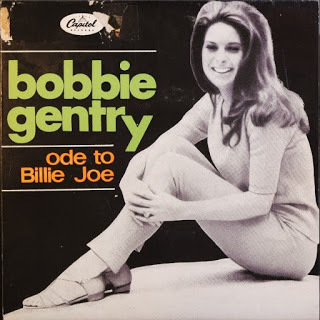 Gentry has said that she doesn't know what Billy Jo (the spelling in the lyrics) and the girl threw off the Tallahatchie Bridge, which seems likely; it's also not clear, for example, that Margaret Mitchell knew any more about the future of Rhett and Scarlett than her readers. "Tomorrow is another day" tells us only that Scarlett isn't defeated and that all things are possible. There's a bit of Schrodinger's cat in there too. Gentry's allusions/illusions leave a number of possibilities open, none of them definitive. She has said that the lyrics focus on the cold, nonchalant way the girl's family discusses Billy Joe's suicide, and with this, Gentry captures the essence of small-town life and gossip. With the Vietnam War and anti-war protests dominating the news, the family turns its attention to something local that each of them knows something about. Papa says Billy Joe "never had a lick of sense," Brother says he talked to Billy Joe after church last Sunday night and ran into him at the sawmill, and Mama mentions that the new preacher saw a girl who looked a lot like her daughter with Billy Joe throwing something off the bridge. All of these references, and the casual ones to what seems to be a tragic suicide, are interspersed with "pass the biscuits, please" and "I'll have another piece of apple pie." Cheesy? No way; that’s poetry thar! – Sincerely, B. Gentry.
Gentry has said that she doesn't know what Billy Jo (the spelling in the lyrics) and the girl threw off the Tallahatchie Bridge, which seems likely; it's also not clear, for example, that Margaret Mitchell knew any more about the future of Rhett and Scarlett than her readers. "Tomorrow is another day" tells us only that Scarlett isn't defeated and that all things are possible. There's a bit of Schrodinger's cat in there too. Gentry's allusions/illusions leave a number of possibilities open, none of them definitive. She has said that the lyrics focus on the cold, nonchalant way the girl's family discusses Billy Joe's suicide, and with this, Gentry captures the essence of small-town life and gossip. With the Vietnam War and anti-war protests dominating the news, the family turns its attention to something local that each of them knows something about. Papa says Billy Joe "never had a lick of sense," Brother says he talked to Billy Joe after church last Sunday night and ran into him at the sawmill, and Mama mentions that the new preacher saw a girl who looked a lot like her daughter with Billy Joe throwing something off the bridge. All of these references, and the casual ones to what seems to be a tragic suicide, are interspersed with "pass the biscuits, please" and "I'll have another piece of apple pie." Cheesy? No way; that’s poetry thar! – Sincerely, B. Gentry.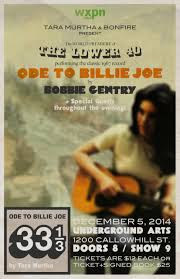 Gentry's lyrics unveil the underlying story. Brother says, "You know, it don’t seem right," indicating that Billy Joe didn't seem suicidal. Now there are two mysteries: What did he (and the girl) throw off the bridge, and why did he suddenly kill himself? Are the two events related? How? As well, the girl's identity does not seem to be part of the mystery. She is quiet during the conversation and doesn't even comment when Brother mentions a prank played on her, meanwhile her mother notices her lack of appetite. If she is the girl who was with Billie Joe (and come on, she is), she keeps it to herself and doesn't want anyone to know . Her family, consciously or unconsciously, adds to her feelings of grief and possibly her guilt.
Gentry's lyrics unveil the underlying story. Brother says, "You know, it don’t seem right," indicating that Billy Joe didn't seem suicidal. Now there are two mysteries: What did he (and the girl) throw off the bridge, and why did he suddenly kill himself? Are the two events related? How? As well, the girl's identity does not seem to be part of the mystery. She is quiet during the conversation and doesn't even comment when Brother mentions a prank played on her, meanwhile her mother notices her lack of appetite. If she is the girl who was with Billie Joe (and come on, she is), she keeps it to herself and doesn't want anyone to know . Her family, consciously or unconsciously, adds to her feelings of grief and possibly her guilt.What makes "Ode to Billie Joe" poetic is the spare but effective way in which the story is told. Nothing is stated, leaving much to be inferred. By the end, through only a few details, the listener (or reader) can see how the family might represent the decline of small-town farming America. With the father dead, Brother abandons the farm for his wife and their new store in town, and the mother and daughter are left with their grief for their respective losses. Gentry doesn't describe Choctaw Ridge or the Tallahatchie Bridge, but we don't need to know what they look like for them to serve as the song's emotional center. The rhythm of the names, combined with their repetition, sears them into our memories. Gentry once said the song was really about indifference, and was, as she described it "A study in unconscious cruelty." She went on to say, "Those questions are of secondary importance in my mind. The story of Billie Joe has two more interesting underlying themes. First, the illustration of a group of people's reactions to the life and death of Billie Joe, and its subsequent effect on their lives, is made. Second, the obvious gap between the girl and her mother is shown, when both women experience a common loss (first, Billie Joe and, later, Papa), and yet Mama and the girl are unable to recognize their mutual loss or share their grief."
"Ode to Billie Joe" was Gentry's debut single, recorded in 40 minutes on July 10 1967. Gentry accompanied herself on acoustic guitar and strings were added later. The original version of the song was 7 minutes, cut down to 4 and released it as a single. The song sold over 3 million copies and Gentry won 3 Grammy awards, including Best Artist, the first country artist to win the award. And for me, pretty good score for $2.99.
It was the third of June, another sleepy, dusty Delta day.
I was out choppin' cotton and my brother was balin' hay.
And at dinner time we stopped and we walked back to the house to eat.
And mama hollered at the back door, "Y'all remember to wipe your feet."
And then she said she got some news this mornin' from Choctaw Ridge
Today Billy Joe MacAllister jumped off the Tallahatchie Bridge.Papa said to mama as he passed around the black-eyed peas,
"Well, Billy Joe never had a lick of sense, pass the biscuits, please."
"There's five more acres in the lower forty I've got to plow."
Mama said it was shame about Billy Joe, anyhow.
Seems like nothin' ever comes to no good up on Choctaw Ridge,
And now Billy Joe MacAllister's jumped off the Tallahatchie BridgeAnd brother said he recollected when he and Tom and Billy Joe
Put a frog down my back at the Carroll County picture show.
And wasn't I talkin' to him after church last Sunday night?
"I'll have another piece of apple pie, you know it don't seem right.
I saw him at the sawmill yesterday on Choctaw Ridge,
And now you tell me Billy Joe's jumped off the Tallahatchie Bridge."Mama said to me "Child, what's happened to your appetite?
I've been cookin' all morning and you haven't touched a single bite.
That nice young preacher, Brother Taylor, dropped by today,
Said he'd be pleased to have dinner on Sunday. Oh, by the way,
He said he saw a girl that looked a lot like you up on Choctaw Ridge
And she and Billy Joe was throwing somethin' off the Tallahatchie Bridge."
A year has come 'n' gone since we heard the news 'bout Billy Joe.
Brother married Becky Thompson, they bought a store in Tupelo.
There was a virus going 'round, papa caught it and he died last spring,
And now mama doesn't seem to wanna do much of anything.
And me, I spend a lot of time pickin' flowers up on Choctaw Ridge,
And drop them into the muddy water off the Tallahatchie Bridge.
Published on June 24, 2019 18:37
June 18, 2019
Buy The Book
Last week there were 52,500 listeners to the AM broadcast, and many of you readers fit into that category as well. We at AM thank you for your loyalty, for listening, for reading and for writing us with your questions and suggestions.
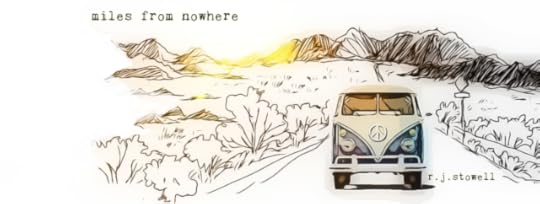
Now it's time to Read the Book! AM, here on the web and on the radio, is sponsored by your patronage through the sale of R.J. Stowell's novel, Miles From Nowhere (and from Jay and the Americans). We've arranged for you to read Miles on Kindle Unlimited FREE, while the Kindle edition for those of you without KU is just $2.99. The trade edition is $10.99, a beautiful softbound edition perfect for relaxing in the sun.
And here's a new offer because you've asked. Now you can get a personally signed edition of either novel for just $15.99. I will sign the novel to you or a loved one with a personal note. Send an email to this link:
rjsomeone@gmail.com
Some of you emailed me about the cover art for Miles. I created the cover with a pen and ink drawing of the landscape. From there, I cartoonized a photo of a VW van and superimposed the peace symbol for the Kindle edition. For the trade paperback, I utilized the cartoon version of the van and created an ink drawing adding watercolor. I scanned the artwork and on the computer added the sun and its rays in the distance. I felt it was important to be hands-on with the cover as well as what was inside. It's the same approach I took with my first published novel, Jay and the Americans, also available from Amazon.

Published on June 18, 2019 11:00
June 17, 2019
Starting Your Collection
50 years ago, we were looking the 60s in the rear-view mirror; the British Invasion, the Summer of Love and Psychedelia were all behind us. Acts like Donovan, Jefferson Airplane and Country Joe and the Fish were at their pinnacle but fading. The Byrds had found new life in country and Crosby, Stills, Nash and Young had left their 60s counterparts to find each other. But it was the birth of something new as well, and so as The Beatles gave us Let It Be and Abbey Road, the Stones Let It Bleed and The Moody Blues shed their skin with LPs like On the Threshold of a Dream, so many new artists were on the horizon: Led Zeppelin, Pink Floyd, Fleetwood Mac, Yes, Cat Stevens, Chicago, the Allman Brothers, Rush, King Crimson, Black Sabbath, Alice Cooper – a new powerful force in rock was upon us, the 70s.
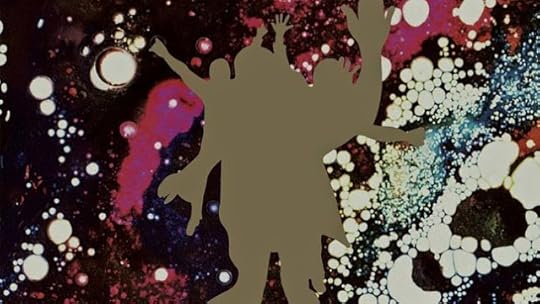
And now, particularly with the downfall of iTunes and the 50th anniversary of so many incredible LPs, what a great time for the resurgence of vinyl. Indeed, the sector grew nearly 12% in 2018 with 9.7 million albums sold, making 2018 the biggest selling year for LPs since 1993.
People often ask when they restart their record collection if they should collect new vinyl releases or seek out the original pressings. This is a great detractor when starting out. New LPs and reissues have questionable quality, something you should think about before you plunk down 30 bucks. Some, as in the case of Sgt. Pepper for the 50th Anniversary and the boxed sets are releases that may indeed exceed what they were originally. The sound quality is among the best on vinyl. On the other hand, the latest pressing of Sgt. Pepper is a remix of the original enhancing the stereo and giving a bit more of a modern vibe – I'd go so far as to say it sounds a bit digital. Don't get me wrong, it's a feast for the ears, but as a collector, you may also want to go out and get yourself an original copy for its historic significance and for comparison. And don't forget the mono version, which is what the original mix was and is the ultimate listening experience if you're looking to capture the original sound. See, it's complicated.
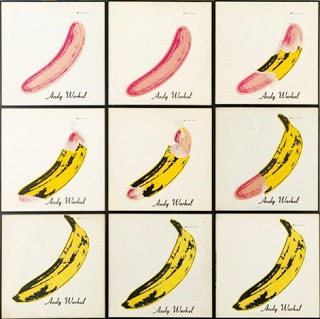 On the other, other hand, much of what is released isn't any good at all. Packaging tends to improve, but, for instance, in the case of the 50th-anniversary edition of The Velvet Underground and Nico, this is among the worst vinyl pressings I've heard. The packaging is quite good, and the banana peel is there tempting you to "Peel Here," but if you're seeking the musical experience of one of the great LPs of the 60s, you won't find it here. Buy this one now at the sticker price – less than 25 bucks – and save it for its value as a collectible. A few years from now it will command a hundred dollars, then if you can't come up with the big bucks for a decent copy, stick to Spotify.
On the other, other hand, much of what is released isn't any good at all. Packaging tends to improve, but, for instance, in the case of the 50th-anniversary edition of The Velvet Underground and Nico, this is among the worst vinyl pressings I've heard. The packaging is quite good, and the banana peel is there tempting you to "Peel Here," but if you're seeking the musical experience of one of the great LPs of the 60s, you won't find it here. Buy this one now at the sticker price – less than 25 bucks – and save it for its value as a collectible. A few years from now it will command a hundred dollars, then if you can't come up with the big bucks for a decent copy, stick to Spotify.For new music, of course, you have no choice but to buy new vinyl, and yet the quality of the pressing still comes into question. And don't be fooled by the myriad of 12-inch 45 rpm pressings that promise, based on the increase in revolutions, to enhance the experience. It may be your only choice, but I don't buy into the increase in quality, particularly when the 45 is pressed on colored vinyl. For the most part, colored vinyl, while cool, just plain sucks. If you're looking for quality sound, stick to basic black. Not to mention how annoying the format is with three songs per side. It's a bit of a sticking point in the vinyl trend: buyers want to buy the LP on vinyl but the quality may be, often is, inferior to the CD pressing or the original. As time goes by, and as vinyl gets more popular, we will have to readdress this.
 But I'd be remiss if I left you hanging. And so, I'd like to share five new pressings that are a must have in your collection: No. 1. Jimi Hendrix' Electric Ladyland, a gorgeous package that includes three LPs and video footage, most importantly the beautifully remastered LPs by Bernie Grundman with Linda McCartney's original cover concept. Hendrix' masterpiece, Electric Ladyland is every bit as important as Sgt. Pepper or Pet Sounds. This is the album you get for friends who say, "I’m not that into Hendrix." They soon will be. Aside from Noel Redding and Mitch Mitchell, the other two members of the Jimi Hendrix Experience, guest artists include Dave Mason, Al Kooper, Buddy Miles and Brian Jones of the Rolling Stones, who acted as percussionist for Dylan's "All Along the Watchtower."
But I'd be remiss if I left you hanging. And so, I'd like to share five new pressings that are a must have in your collection: No. 1. Jimi Hendrix' Electric Ladyland, a gorgeous package that includes three LPs and video footage, most importantly the beautifully remastered LPs by Bernie Grundman with Linda McCartney's original cover concept. Hendrix' masterpiece, Electric Ladyland is every bit as important as Sgt. Pepper or Pet Sounds. This is the album you get for friends who say, "I’m not that into Hendrix." They soon will be. Aside from Noel Redding and Mitch Mitchell, the other two members of the Jimi Hendrix Experience, guest artists include Dave Mason, Al Kooper, Buddy Miles and Brian Jones of the Rolling Stones, who acted as percussionist for Dylan's "All Along the Watchtower."Nos. 2 and 3 are Pink Floyd's The Piper at the Gates of Dawn and A Saucerful of Secrets – the first and second LPs from the band while still with Syd Barrett. The Record Store Day Pressings are amazingly high-quality reissues, both, by the way, in mono. That's a key ingredient here, the quality of the vinyl itself is incomparable and the packaging follows suit. For Piper, a great Hipgnosis outer cover has the instantly recognizable prism photo by photographer Vic Sign within. One would think the photo was edited in the studio, instead, Sign used a Zeiss lens through a prism given to him by George Harrison. For me, the psychedelic era was so underrated with standouts like Surrealistic Pillow by the Jefferson Airplane, Love’s Forever Changes and more obscure works like Of Cabbages and Kings by Chad and Jeremy or Mrs. Butter by The Family Tree, but Pink Floyd, of Course, transcends the genre. And don't think you’re getting anything second best with the mono pressings; Dark Side, Meddle and the rest need stereo and Wish You Were Here nearly demands quadrophonic sound, but Piper and Saucerful are wall of sound giants that don't require any trickery.
No. 4 is Music From Big Pink by the Band. Here is something distinctive with a high-quality mix that is anything but the original. It's a whole different LP that purists may not admire, but audiophiles will. You'll need both versions to make your analysis. As everyone knows, The Beatles paid their dues in the seedy underbelly of Hamburg Germany; The Band, on the other hand, had ten years back up experience before they hooked up with Dylan for the electric tour in 1965 and 6. By the time The Band recorded their first studio album, they had perfected a unique playing style - no one instrument dominating the others; instead there's a sense of impeccable communication that blends the deep groove of blues and soul with honky-tonk piano, rockabilly, loping carnival lines and an amazing blend of voices. The new mix allows the listener a sonic experience that the original pressing wasn't about. For me, a new mix and a new pressing are a hard sell, but Big Pinkis a must.
Finally, DeadHeads, anyone, actually, should have a listen to American Beauty, an older re-release that some find issue with; the mix for "Box of Rain" for instance is a bit odd and off-putting at first, but other than that, Bernie Grundman’s remastered American Beauty is that perfect Sunday afternoon lazin’ around LP and the reissue somehow highlights the sunshine. Sit down, light up and enjoy the day. I'm a bit torn, here. That said, part of me wants to say, get the original and wait a couple years; pretty sure there will be a 50th re-release of the Dead's pinnacle studio LP.
Published on June 17, 2019 11:50
June 7, 2019
CSN - Y, Too
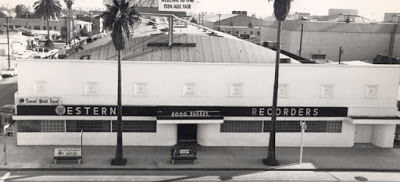 In June 1966, Graham Nash and the Hollies met the Mamas and the Papas at a Hollies press party at Imperial Records. Nash hit it off right away with Cass Elliot and Cass who invited Graham to a Mamas and Papas recording session of "Dancing Bear" at Western Recorders on Sunset Boulevard. Fast forward to February 1968 where the Hollies played a Valentine's gig at the Whiskey a Go-Go. Micky Dolenz introduced the show and Stephen Stills and David Crosby were right up front. In April, Cass would introduce Nash to Crosby and Stills at her house in Laurel Canyon and the catalyst for CSN was set into motion. By the end of 1968, Nash took leave of the Hollies, content to consider his future from the restorative oasis that was Laurel Canyon, not to mention his Our House kind of life with Joni Mitchell. We've talked before about the haphazard way in which bands, particularly supergroups are formed. It was fifty years ago that the CSN's eponymous LP was released and none of its luster is lost 50 years on. "Suite: Judy Blue Eyes," alongside "Wooden Ships," "Helplessly Hoping," and "Guinevere" sound as fresh today as anything by Lord Huron, Fleet Foxes or the new Americana sounds.
In June 1966, Graham Nash and the Hollies met the Mamas and the Papas at a Hollies press party at Imperial Records. Nash hit it off right away with Cass Elliot and Cass who invited Graham to a Mamas and Papas recording session of "Dancing Bear" at Western Recorders on Sunset Boulevard. Fast forward to February 1968 where the Hollies played a Valentine's gig at the Whiskey a Go-Go. Micky Dolenz introduced the show and Stephen Stills and David Crosby were right up front. In April, Cass would introduce Nash to Crosby and Stills at her house in Laurel Canyon and the catalyst for CSN was set into motion. By the end of 1968, Nash took leave of the Hollies, content to consider his future from the restorative oasis that was Laurel Canyon, not to mention his Our House kind of life with Joni Mitchell. We've talked before about the haphazard way in which bands, particularly supergroups are formed. It was fifty years ago that the CSN's eponymous LP was released and none of its luster is lost 50 years on. "Suite: Judy Blue Eyes," alongside "Wooden Ships," "Helplessly Hoping," and "Guinevere" sound as fresh today as anything by Lord Huron, Fleet Foxes or the new Americana sounds.Interestingly, one of the most famous of the CSN debut tracks was "Marrakesh Express," a song Nash had written for the Hollies. He said he was in England reading about the middle eastern journeys of William Burroughs and Allen Ginsberg. Here I quote: "So, I grab my wife, Rose, and we took the train down from Casablanca down to Marrakesh. All my pores were open. I was just soaking in this atmosphere." That in mind, listen to the track again to get the vibe and imagine the scene. He said, "I was carrying all these tunes in my pocket just waiting for the right moment." Donovan had fostered the notion that Nash could make it on his own, and in the meantime taught him to fingerpick. Nash found himself floundering in the Hollies who weren’t receptive to songs like "Marrakesh Express" or "Teach Your Children" and when he met Crosby, Crosby said, "Don’t even listen to what they are saying. They're totally fucked. I love those songs."
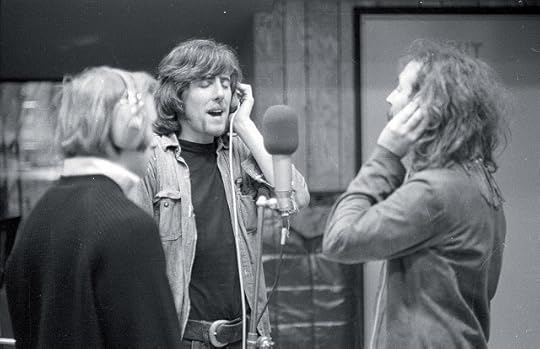 There is little on the LP that doesn't work. With its soaring harmonies and layered guitars, "Suite: Judy Blue Eyes" is an epic opener, one that even FM overkill can't kill. "Marrakesh Express" is infectious, "Guinevere" is an ethereal masterpiece that delicately conveys the sense of drugged-up wonder in which Crosby was immersed at the time. And "Wooden Ships" is amazing. The lyrics speak of a post-apocalyptic world when human beings finally realize that we cannot be enemies and survive. "Long Time Gone" is an angry yet heart-wrenching track on the assassination of RFK. Crosby's delivery is impeccable. And finally, we get "49 Bye-Byes," a closer worthy of the awe-inspiring music that has come before it.
There is little on the LP that doesn't work. With its soaring harmonies and layered guitars, "Suite: Judy Blue Eyes" is an epic opener, one that even FM overkill can't kill. "Marrakesh Express" is infectious, "Guinevere" is an ethereal masterpiece that delicately conveys the sense of drugged-up wonder in which Crosby was immersed at the time. And "Wooden Ships" is amazing. The lyrics speak of a post-apocalyptic world when human beings finally realize that we cannot be enemies and survive. "Long Time Gone" is an angry yet heart-wrenching track on the assassination of RFK. Crosby's delivery is impeccable. And finally, we get "49 Bye-Byes," a closer worthy of the awe-inspiring music that has come before it. Three months later, without any rehearsal time, the trio got together with Neil Young to play Woodstock. There are but a handful of important sets at Woodstock – Santana, Joe Cocker, Hendrix, but it was Crosby, Stills, Nash and Young who epitomized what Woodstock was all about.
Two interesting things. The band was introduced as Buffalo Springfield, which of course was inaccurate, and following an incredible set with just Crosby, Stills and Nash, Young milling about in the background of what is referred to as the acoustic session (only joining in for two songs), the rest of the show was a hard-rocking guitar-oriented session with Stills and Young taking the reins. The band, of course, would go on to release Déjà vu just a few months later, which remains one of rock's timeless gems.
Published on June 07, 2019 06:58
June 5, 2019
Yoko - Opinion
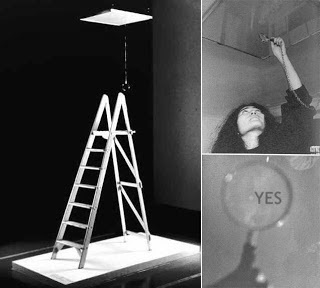 We put a lot of emphasis on Yoko, the woman who broke up the Beatles, who howled instead of sang, the cause of the escalation in the Vietnam War, global cooling and cyclamates.
We put a lot of emphasis on Yoko, the woman who broke up the Beatles, who howled instead of sang, the cause of the escalation in the Vietnam War, global cooling and cyclamates. In reality, Yoko Ono was a major figure in the 60s art scene, whose work contributed to conceptualism, Fluxus and op art. Some will maintain she was also a musical pioneer in punk, riot grrl feminism, lo-fi, art rock, and noise pop (eh, IDK).
Whatever your assessment – continue to hate as you please – but isn't it time that we put aside the inherent racism and admit that Yoko was the love of John's life and therefore the impetus behind both Plastic Ono Band and Imagine. There is certainly that argument to be made. By now, you'd think we'd be over it.
I think we're all still enamored, for instance, when the Beatles in Help! each went into a different door that connected the same flat. Funny, charming, a part of our eternal fantasy with the Beatles. I love that scene, but honestly, Yoko didn’t break up the Beatles, the Beatles just plain grew up - and that was, indeed, a fantasy.
One of my favorite rock vignettes comes from 1966 when John met Yoko at the Indica Art Gallery in London. The American art scene had eclipsed that in London, despite the work of Peter Blake and Richard Hamilton, David Hockney. The focus of pop art was clearly in New York with Warhol and the Factory, with Lichtenstein and Rauschenberg. Art in London still wore a three-piece suit. But not at the Indica, and on November 9, 1966, John entered the gallery.
John Lennon: There was a sort of underground clique in London; John Dunbar, who was married to Marianne Faithfull, had an art gallery in London called Indica, and I'd been going around to galleries a bit on me off days in between records, also to a few exhibitions in different galleries that showed sort of unknown artists or underground artists.
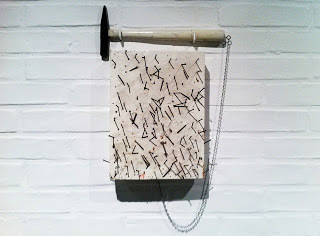 I got the word that this amazing woman was putting on a show the next week, something about people in bags, in black bags, and it was going to be a bit of a happening and all that. So, I went to a preview the night before it opened. I went in - she didn't know who I was or anything - and I was wandering around. There were a couple of artsy-type students who had been helping, lying around there in the gallery, and I was looking at it and was astounded. There was an apple on sale there for two hundred quid; I thought it was fantastic - I got the humor in her work immediately. I didn't have to have much knowledge about avant-garde or underground art, the humor got me straight away. It was two hundred quid to watch the fresh apple decompose.
I got the word that this amazing woman was putting on a show the next week, something about people in bags, in black bags, and it was going to be a bit of a happening and all that. So, I went to a preview the night before it opened. I went in - she didn't know who I was or anything - and I was wandering around. There were a couple of artsy-type students who had been helping, lying around there in the gallery, and I was looking at it and was astounded. There was an apple on sale there for two hundred quid; I thought it was fantastic - I got the humor in her work immediately. I didn't have to have much knowledge about avant-garde or underground art, the humor got me straight away. It was two hundred quid to watch the fresh apple decompose.But it was another piece that really decided me for or against the artist: a ladder that led to a painting, which was hung on the ceiling. It looked like a white canvas with a chain with a spyglass hanging on the end of it. I climbed the ladder, looked through the spyglass, and in tiny little letters it said, YES.
So, it was positive. I felt relieved. It's a great relief when you get up the ladder and you look through the spyglass and it doesn't say NO or FUCK YOU or something.
The point is that 50 years ago the couple married at Gibraltar, the events of the day captured in the Beatles' hit single "The Ballad of John and Yoko," on which only John and Paul performed. George was away on holiday and Ringo was filming The Magic Christian with Peter Sellars. As a bit of a gag, within the song you can hear Lennon say, "Go a bit faster, Ringo," and Paul shout, "OK, George." The Beatles hadn't lost their sense of humor. Maybe we should try and find ours. How many bands have an unblemished 11 LP streak (think what may have happened)? Where would we be today without Imagine or "Live and Let Die"? Time we get over it, eh?
Published on June 05, 2019 05:15



